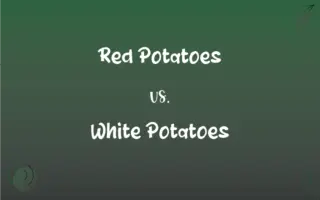Holozoic Nutrition vs. Holophytic Nutrition: What's the Difference?
Edited by Aimie Carlson || By Harlon Moss || Updated on October 20, 2023
Holozoic nutrition involves ingesting solid food particles, while holophytic nutrition is the synthesis of food via photosynthesis.

Key Differences
Holozoic nutrition and holophytic nutrition are two distinct methods organisms employ to derive essential nutrients. Holozoic nutrition is characterized by the consumption and digestion of solid food particles. Typically associated with animals, this method involves ingestion, digestion, absorption, and egestion. For example, when a lion consumes its prey, it's following the holozoic nutrition pattern, breaking down complex foods into simpler substances suitable for assimilation.
Holophytic nutrition, on the other hand, primarily pertains to the process plants undergo—photosynthesis. This method is about producing food using sunlight, carbon dioxide, and water. The process transforms light energy into chemical energy in the form of glucose or other sugars. Essentially, organisms employing holophytic nutrition create their own food rather than consuming other living beings.
While holozoic nutrition emphasizes the intake of preformed organic molecules from other organisms, holophytic nutrition emphasizes the creation of these molecules in the organism itself. A major distinction lies in the energy source: holozoic nutrition derives energy from consumed organisms, whereas holophytic nutrition harnesses energy directly from the sun.
To sum it up, holozoic nutrition is more of a consumer-based approach, where organisms feed on others to derive necessary nutrients. In contrast, holophytic nutrition represents a producer-based approach, where organisms manufacture their own food using external energy sources like sunlight.
Comparison Chart
Primary Method
Ingestion of solid food particles
Photosynthesis using sunlight, carbon dioxide, and water
ADVERTISEMENT
Typical Organisms
Animals
Plants and some algae
Energy Source
Derived from consumed organisms
Directly from the sun
Process Phases
Ingestion, digestion, absorption, egestion
Light and dark reactions of photosynthesis
Dependency
Dependent on other organisms for food
Self-sustaining, producing its own food
Holozoic Nutrition and Holophytic Nutrition Definitions
Holozoic Nutrition
Nutrition involving a sequence of ingestion to egestion.
Predators like tigers rely on holozoic nutrition to survive.
ADVERTISEMENT
Holophytic Nutrition
The transformation of light energy into chemical energy as food.
Using holophytic nutrition, algae can thrive in well-lit waters.
Holozoic Nutrition
Nutrition involving the ingestion and digestion of solid foods.
Humans follow holozoic nutrition by eating varied diets.
Holophytic Nutrition
Food production through photosynthesis.
Trees exhibit holophytic nutrition by converting sunlight into glucose.
Holozoic Nutrition
A method where organisms consume others to derive energy.
Birds catching worms demonstrate holozoic nutrition in action.
Holophytic Nutrition
A producer-based approach to nutrition, creating food internally.
Cacti, despite harsh conditions, perform holophytic nutrition.
Holozoic Nutrition
An intake-based approach to derive essential nutrients.
Fish exhibit holozoic nutrition by consuming smaller aquatic organisms.
Holophytic Nutrition
Self-sustaining nutrition synthesizing sugars from sunlight.
Green shrubs employ holophytic nutrition for sustenance.
Holozoic Nutrition
The breakdown of complex food into simpler absorbable substances.
The process of holozoic nutrition ensures energy conversion from food.
Holophytic Nutrition
Nutrition method harnessing energy directly from sunlight.
Plants in gardens use holophytic nutrition to grow and flourish.
FAQs
What organisms primarily follow holozoic nutrition?
Animals, including humans, predominantly follow holozoic nutrition.
Which organisms are known for holophytic nutrition?
Plants and some algae are primary users of holophytic nutrition.
Are there any organisms that employ both types of nutrition?
Some protists, like Euglena, can employ both nutrition methods under different conditions.
How do organisms practicing holophytic nutrition obtain energy?
Through photosynthesis, converting sunlight into chemical energy.
What's a common example of holozoic nutrition in daily life?
Humans eating their meals is a clear example of holozoic nutrition.
Can animals ever adapt to holophytic nutrition?
No, animals lack the structures like chloroplasts required for holophytic nutrition.
Do plants rely solely on holophytic nutrition?
While primarily relying on holophytic nutrition, plants also absorb minerals from the soil.
Do all plants undergo holophytic nutrition?
Most, but not all. Some plants, like parasitic plants, don't photosynthesize.
Is digestion crucial in holozoic nutrition?
Yes, digestion breaks down complex food particles into simpler forms suitable for absorption in holozoic nutrition.
What's a critical stage in holozoic nutrition?
Digestion, as it ensures the conversion of food into usable energy.
Is holophytic nutrition exclusive to green plants?
Primarily, but some algae and bacteria also employ this method.
In the absence of sunlight, can holophytic nutrition occur?
No, sunlight is crucial for the photosynthesis process in holophytic nutrition.
What happens to undigested food in holozoic nutrition?
It gets egested or excreted from the organism's body.
Are there specific locations where holophytic nutrition occurs in plants?
Yes, primarily in the chloroplasts within plant cells.
What initiates the holozoic nutrition process?
Ingestion or intake of food starts the holozoic nutrition process.
Which nutrition method is more energy-efficient?
Holophytic nutrition is more energy-efficient as it directly harnesses energy from the sun.
Are there other methods of nutrition apart from holozoic and holophytic?
Yes, there are others like saprophytic and parasitic nutrition.
What's the primary raw material for holophytic nutrition?
Carbon dioxide, water, and sunlight are vital for holophytic nutrition.
Can holozoic nutrition occur without oxygen?
Some phases can, but aerobic digestion in many animals requires oxygen.
Is water essential for holophytic nutrition?
Yes, water is a key component in the photosynthesis process.
About Author
Written by
Harlon MossHarlon is a seasoned quality moderator and accomplished content writer for Difference Wiki. An alumnus of the prestigious University of California, he earned his degree in Computer Science. Leveraging his academic background, Harlon brings a meticulous and informed perspective to his work, ensuring content accuracy and excellence.
Edited by
Aimie CarlsonAimie Carlson, holding a master's degree in English literature, is a fervent English language enthusiast. She lends her writing talents to Difference Wiki, a prominent website that specializes in comparisons, offering readers insightful analyses that both captivate and inform.






































































